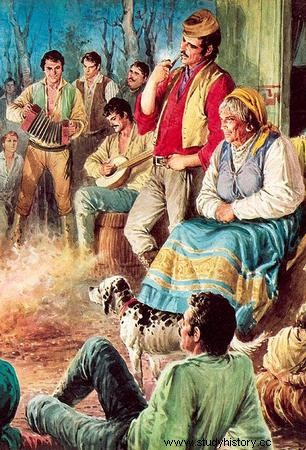Repainting? Masking the flaws with inconceivable methods? Sounds familiar? Of course, these are the practices used by many modern used car dealership owners. It's just that they come from the times when the power of a vehicle was measured by the number of ... draft horses.
Among the rural population in modern times, there was a widespread opinion that Gypsies practice magic, predict the future, or undo charms. In fact, they mainly dealt with herbal medicine, music, jewelry making, blacksmithing and - which will interest us today - horse trade.
Gypsies have been associated with horses since time immemorial. Like a long and broad Europe, they always moved with them. What's more, they had something like their own breeds of horses, created as a result of crossing different lines and obtaining the desired qualities, such as endurance, strength, speed, or low feed requirements (the horse often had to eat only what grew in the pasture area) .

I wonder what this Gypsy with a pipe is so proud of? Maybe how to push another "injured" horse?
Traveling all their lives, Gypsies watched their horses and, like no one else, knew how to care for them and how to treat them in case of illness. They used their skills not only on the road.
Lord! Almost new, no accidents, look under the hood ...
Nowadays, when buying a used car, we most often go to a commission shop. There, a smiling salesman waits for us and, praising his goods, tells the miracles of invisibility. All cars are accident-free, from the first owner and absolutely not patted. Well ... a trained eye is enough and you can still catch bumps and tricks. It turns out that the methods of selling four-wheel drive / hoof "means of transport" (delete as appropriate) have remained unchanged for a long time.
Gypsies had a flair for business. When they traveled through a country, they bought horses where they were cheap and sold them elsewhere. They purchased sick pieces and treated them up before sale, or by methods known to themselves, improved their appearance and condition, at least for a short while, which was enough to sell a given specimen. We are familiar with the saying "a donated horse is not looked in the teeth". It didn't come out of thin air.

I wonder if the horses in this painting were also repainted?
In this case, the degree of tooth wear is indicative of the animal's age. And clever traders found a way to do that. The poor horses were going through solid dental procedures without anesthesia. In order to mask their age, grooves were carved in their teeth and filled with tar.
It should be honestly added that representatives of other nations also used similar methods. There is even a word in English for the seller of poor, crunchy horses - horse-capper.
Horse as (after) painted!
When the horse changed hands at night, as a matter of urgency and rather against the letter of the law, it had to be sold quickly. Modern slang would describe it as "hot stuff". How to "liquefy" such an animal even under the very nose of the original owner? Well, it's best to… repaint them.
Exactly! The Gypsy dyed the hair and mane of the stolen horse, and then as if nothing had happened, he sold the animal at the market. After some time, the horse's coat color returned to its original state, of course, but that was the sadness of the new owner.
It turns out that the artistic aspirations of the Gypsies went beyond the horse's hair. As Jerzy Ficowski writes, they made themselves felt in the 1980s. In the vicinity of Hel and in Wrocław, Gypsies were selling exotic birds with cages at the market.

As it turns out, the Gypsies were great at repainting not only horses. They did just as well with the sparrows, which they later sold as canaries and parakeets (photo:Kookaburra; license CC ASA 3.0).
An incredible bargain, and the price is affordable! Those who were tempted and purchased cute birds had delicious food. It turned out that in the cage was not a canary or a parakeet, but the most ordinary passer domesticus , a Polish gray sparrow, but fancifully painted by clever Gypsies.
